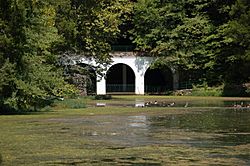Dunbar Cave State Park facts for kids
Dunbar Cave State Park is a cool 110-acre (450,000 m²) protected area located in Clarksville, Tennessee. It's famous for Dunbar Cave, which is one of the biggest cave systems in the world! This cave stretches over 8 miles (13 km) underground. The area around the cave has interesting landforms like sinkholes and springs. These are all made from limestone bedrock.
Right at the cave entrance, there's a big concrete structure with three arches. There's also a man-made lake called Swan Lake. Sometimes, the cave has to close to visitors to protect bats. This is because of a sickness called White nose syndrome.
Contents
Discovering Dunbar Cave's Past
People have used Dunbar Cave for a very long time. Archaeologists found tools and other items here. Some of these items date back to the Paleo Indian time (10,000–8,000 B.C.). Most of the discoveries are from the Archaic time (8,000–1,000 B.C.).
Native American Life at the Cave
During the Woodland time (1,000 B.C. – 800 A.D.), fewer people lived right by the cave. Native Americans started growing more crops. The land near the Red River and Cumberland River was better for farming.
Later, in the Mississippian era (800–1550 A.D.), the cave became very important. Native Americans used it for special ceremonies. They drew religious symbols on the cave walls. This shows that they believed the cave was a sacred place.
Who Owned the Cave?
In 1784, a man named Thomas Dunbar claimed the land. But he never got the official deed. Around 1790, a land surveyor named Robert Nelsen realized this. He then claimed the land for himself.
A legal fight happened, and in 1792, the U.S. Government gave the land to Robert Nelsen. The Dunbar family had to leave.
Mining and Early Tourism
During the Mexican–American War, the cave was used for mining. Workers dug out saltpeter, which is an important ingredient for gunpowder.
In 1858, people saw how special the area was. They built the first cabins near the cave. After the American Civil War, a man named J. A. Tate bought the springs and the cave. He built a two-story hotel there.
A Popular Entertainment Spot
By 1931, the area was a popular place for social events. People came for dances, concerts, and fairs. The hotel and facilities needed some repairs. Local business owners helped clean up the site. They added a concrete swimming pool, a bathhouse, and tennis courts.
They also made the existing lake bigger, turning it into a 20-acre (81,000 m²) lake.
Roy Acuff's Time at the Cave
Famous country music star Roy Acuff bought Dunbar Cave on April 26, 1948. He paid $150,000 for it. The cave became a lively spot for music shows. Big bands like Benny Goodman's and Tommy Dorsey's played there. Acuff also added a golf course next to the lake.
Over time, the cave's popularity slowly went down. The hotel burned down in 1950 and was never rebuilt.
Becoming a State Park
McKay King bought Dunbar Cave in 1963. He ran the property until he passed away in 1971. The swimming pool closed in 1967. His wife inherited the cave.
In 1973, the State of Tennessee bought Dunbar Cave from Mrs. McKay King. It then became a State Natural Area. In 2002, the park briefly closed due to state budget cuts.
Ancient Art: Petroglyphs in the Cave
More than 30 drawings and etchings have been found inside Dunbar Cave. These amazing artworks are called petroglyphs. They were made during the Mississippian era (700 to 1300 CE). Researchers used torches and other items found nearby to figure out their age.
Some of the drawings are religious symbols. One even shows a Mississippian supernatural warrior. Park specialist Amy Wallace, geologist Larry E. Matthews, historian Billy Frank Morrison, and professor Joe Douglas discovered these Native American artworks in January 2005. The State of Tennessee announced their discovery to the public in July 2006.
Protecting Bats from White Nose Syndrome
Dunbar Cave is home to a small group of bats. To protect them, the cave is closed from September through April. This allows the bats to hibernate without being disturbed.
What is White Nose Syndrome?
In March 2010, researchers found a bat with White nose syndrome in the cave. This disease is very serious for bats. It has spread across many states and Canada since 2006. It has caused the death of over a million bats.
Because of this discovery, the State of Tennessee closed Dunbar Cave to all visitors and tours on March 24, 2010. The US Fish & Wildlife Service (USFWS) suggests that people avoid caving in affected areas. They also recommend cleaning any clothing or equipment used in caves after each visit. This helps stop the spread of the disease.


